The final week of last month may have ended ophthalmic surgery’s darkest period in history. While turning the lights back on at different times throughout May—like so many Thankful Villages after the Great War—ambulatory surgery centers nationwide resumed elective procedures for the first time in six to 10 weeks. As expected, the last ASCs to open were those in New York. COVID-19 decimated the Empire State with more than 354,370 infections and 28,000 deaths before surgeons there finally gowned up for daylong procedures again, joining their peers throughout the country.
“Our office opened this week and our surgery center will be open for elective cases next week (10 weeks after closing on March 10),” texted a very busy Eric Donnenfeld, MD, on May 21, with no time to talk on the phone
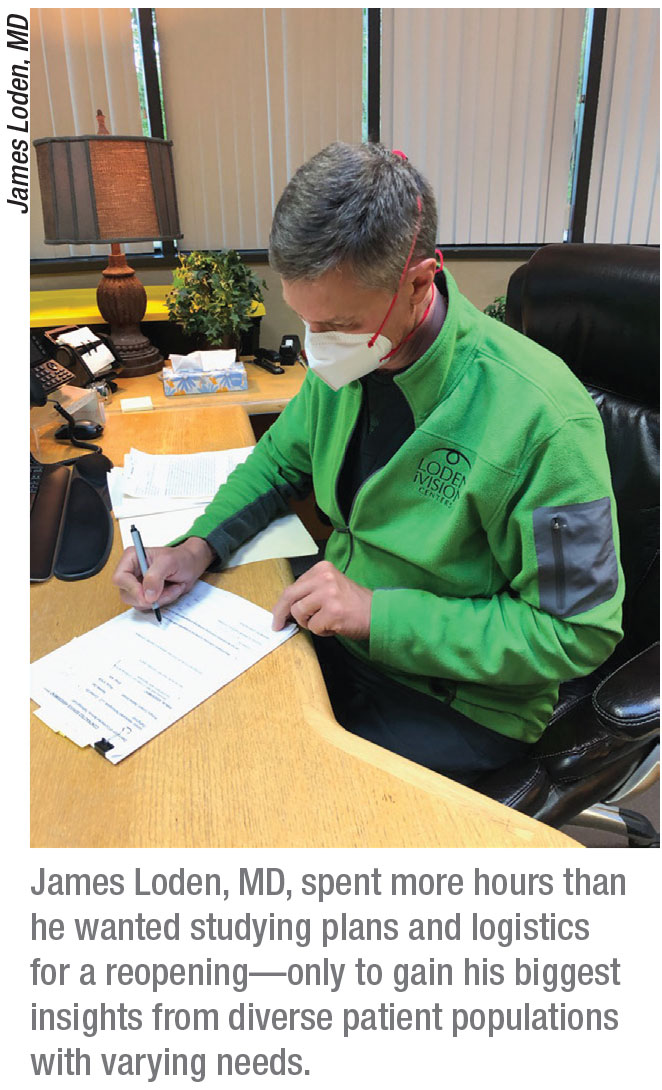 |
Dr. Donnenfeld, of OCLI Vision, operates at Island Eye Surgicenter in Westbury, New York. He’s one of thousands of entrepreneur surgeons across the country who’ve spent countless hours bringing once-humming-then-closed ORs back to life, performing feats of resourcefulness and spontaneous planning that had never been previously attempted.
Read on to find out how these surgeons crossed off the nearly mind-numbing restart checklists from four societies, coordinated staff efforts, planned safety protocols, re-triaged patients-in-waiting and completed numerous unexpected tasks, from the mundane to those of critical importance.
First Response: Lots of Prep
“How do you reopen an ASC and get back to seeing patients again?” Dr. Donnenfeld asks. “Our new mindset needs to focus on the most technologically advanced operation. It also has to be the safest operation intraocularly, minimizing any risk to our patients, their families, our staff and surgeons.”
Dr. Donnenfeld urges every ASC to maintain a vigilant continuation of compliance with state requirements and other guidelines, reviewing dozens of recommendations for how to reopen and continue to operate.
Critical issues are covered on extensive checklists provided by the American Academy of Ophthalmology, the American Society of Cataract and Refractive Surgery and the Outpatient Ophthalmic Surgery Society (aao.org/practice-management/article/ophthalmic-asc-reopening-guidance), as well as the American College of Surgeons (facs.org/covid-19/clinical-guidance.)
“Some decisions are easy to make but some might be a little more difficult,” he admits. “My suggestion is to put together an advisory board consisting of nursing, administration and doctors to decide on the best way to proceed on all issues. We’ve also relied on our colleagues in states where they’ve opened earlier to find out how they’ve handled various hurdles. For example, there’s some debate about what type of mask should be worn. Consider the standard in most ORs. Some people have N-95 masks, which will filter out viruses, but most consider this unnecessary. The important point is that all doctors and nurses and patients should wear masks, and patients should wear masks under their drapes during surgery.”
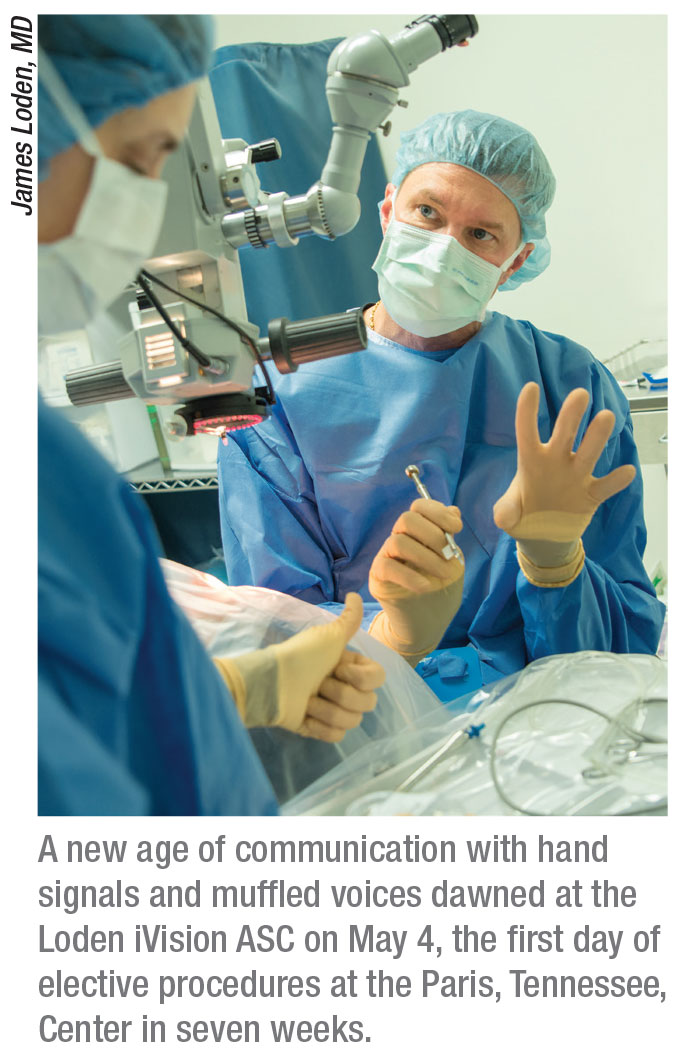 |
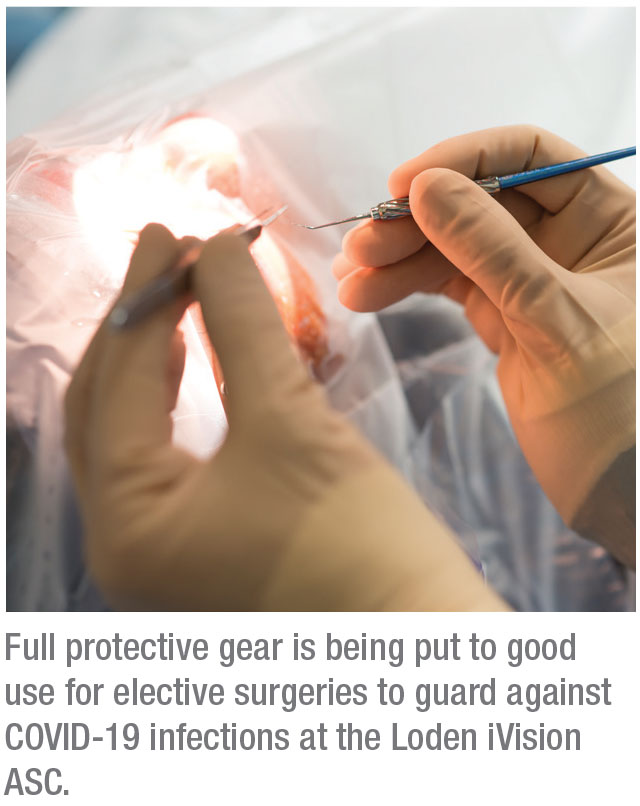 |
Removing a mask and gloves properly is also important to avoid contamination, he adds. “It’s very easy to touch your face and and then remove your masks. You have to follow aggressive sterile technique when you do that. Aggressive hand-washing is also important. And we’re checking the temperature of all patients and staff and doctors when they come into the OR, on a regular basis. “We’re asking all family members to wait in their cars, and we’re going to keep the waiting room as empty as possible,” he says. “We’ve removed chairs from the waiting room to make it impossible for people to sit next to each other, and we’ll be repurposing the room as a transition area.”
Dr. Donnenfeld says his group is resigned to facing “many more hurdles” in the months ahead. “We’re going to need to maintain constant sterilization of all surfaces,” says Dr. Donnenfeld, “and we have reduced our surgical volume by about 40 percent. We will be getting used to a new normal and then, once we get accustomed to the new flow in our ORs, we will begin to ramp up our ORs, hopefully to the same levels we had before.”
Minimizing Patient Interactions
To minimize patients’ personal contact with staff and surgeons in the office, Dr. Donnenfeld says OCLI has relied on telemedicine and minimized “touch services,” encouraging patients to fill out forms online, for example. “We’re triaging our patients based on need and the visual problems they’re having. We’ve had thorough and continuing contact with our patients, which I think is very important.” One challenge is that, in New York, patients need to undergo a physical exam by their general practitioners 30 days before surgery. As a result, a number of patients will need repeat exams before surgery, Dr. Donnenfeld notes.
“One of the controversial areas that we’ve been exploring is whether patients should be checked for COVID-19 infection when they come to see us,” Dr. Donnenfeld says. “The advantage of having the patient checked is knowing that he or she is not infectious. The disadvantage is having to wait two or three days, potentially, for test results. The tests are mildly expensive and limited in sensitivity and specifity, so it’s very common to have false negatives and false positives.”
In Arizona, where Yuri McKee, MD, MS, is a corneal and refractive surgeon at East Valley Ophthalmology in Mesa, he says all patients are required to test negative for COVID-19 before elective surgery.
“So, with a negative test result, with the surgeon wearing a mask, and a judicious use of phacoemulsification energy, I think the risk of surgical-related viral transmission is quite low, but certainly not zero. The simple truth is: We can reduce, but not eliminate, the risk of virus transmission. Straightforward PPE rules should reduce the risk the most.”
Dr. McKee is still weighing approaches to minimizing risk of infection while performing phacoemulsification. “I’ll be wearing a surgical mask and dropping dilute Betadine on the cornea during the case, just as I typically do,” he says. “If a plume evacuator is readily available I would’t object to using it, but I think it’s impractical to expect everyone to find a plume evacuator for phaco surgery. Studies could be done to see how much tear-film aerosolization is caused by the phaco probe. Until more definitive evidence is presented, we’ll need to do the best we can with the information that’s known.”
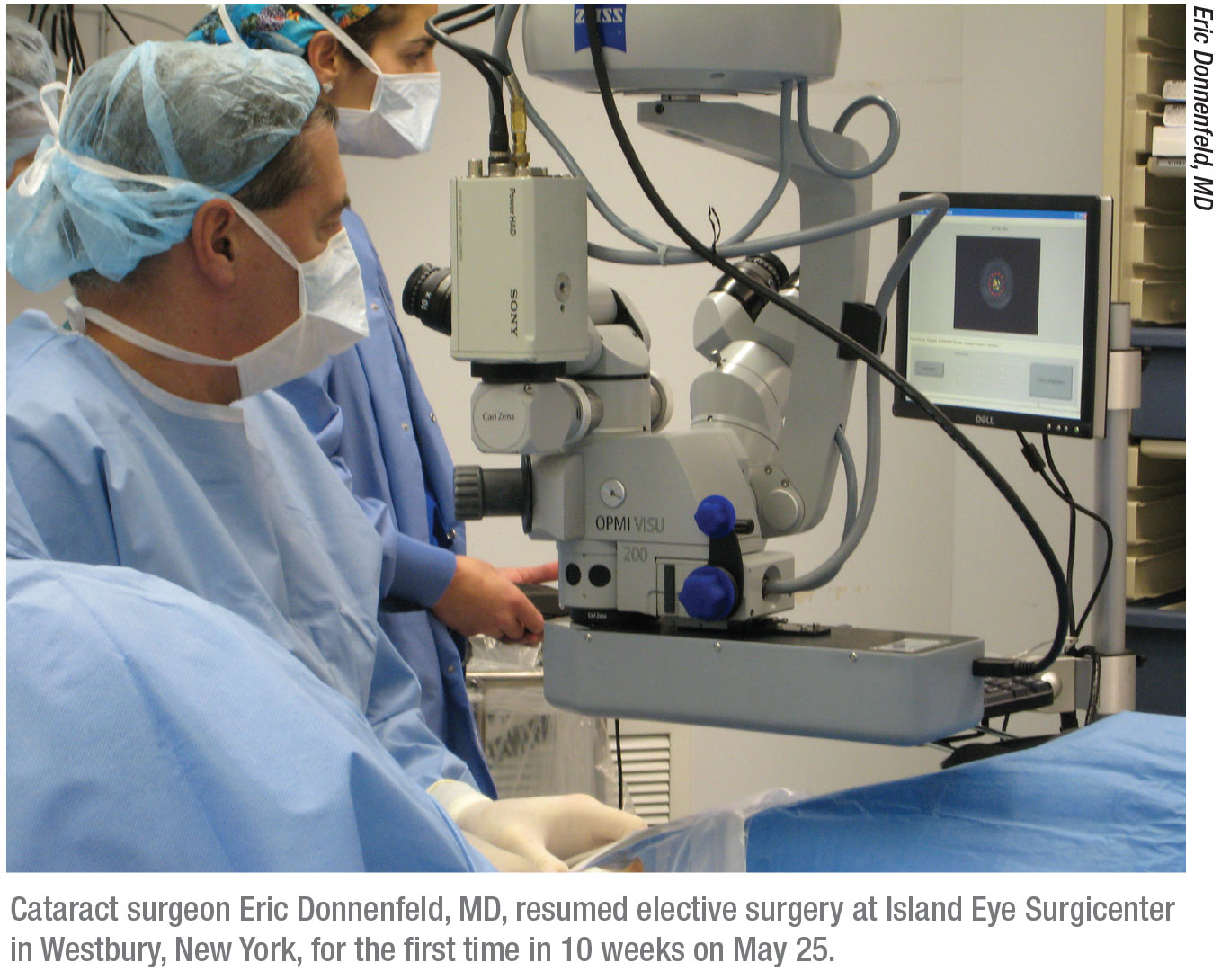 |
Dr. McKee points to one recent investigation by Bristol Eye Hospital in Bristol, United Kingdom, which found that the application of hydroxypropyl methylcellulose (HPMC) once every 60 seconds around the surgical wound during phacoemulsification eliminates visible aerosol. For a demonstration of the investigation, involving human cadaveric scleral models, go to the following link: youtube/8LGwI9LIYmU
On another front, he asks: “Should we be holding off on elective LASIK cases? Well, I’m not doing LASIK right now, but that’s more because I’ve such a backlog of intraocular surgery that I can’t be spending time on elective refractive surgery. At some point, we’ll have to address the idea of viral transmission from the LASIK plume. For these cases, I probably would recommend an N-95 mask or even an industrial NIOSH VOC mask just to limit the chance of viral transmission from a LASIK plume.”
Reduced Risks in Florida
Cataract and refractive surgeon Farrell “Toby” Tyson, MD, owner of TysonEye, which has multiple locations in Florida, including Bonita Springs and Cape Coral, says he isn’t concerned about the risk of infection from aerosolization during phacoemulsification. “I don’t phaco outside of the eye,” he says. “Everybody wears masks, including the patient.”
With less than 2,000 COVID-19 infections reported by May 4 in the counties where he practices, Dr. Tyson’s practice resumed elective procedures on that date. The practice offers femtosecond cataract surgery, glaucoma surgery, custom wavefront LASIK, oculoplastic surgery and retinal care.
“Here we have two different types of patients,” says Dr. Tyson. “One type thinks the threat of COVID-19 infection is overblown. They just want to get their cataracts done and they’re not worried. On the other hand, you have patients who are in a high-risk category who are going to stay locked down until it’s pretty safe. Everybody’s been saying we’re going to have a big boom in surgery cases now that we’ve opened back up, but I don’t see that happening. It’s going to be a slow startup.”
Managing time-consuming protocols to reduce patient crowding and ensure safety, Dr. Tyson only operated at 25 percent of his usual capacity when he started. “Normally I do eight to 10 cases an hour in two operating rooms,” he says. “Now, we have family members waiting in their cars, not the waiting room. With the decreased volume, we don’t have that time pressure going on because we have fewer patients coming through. Of course, we’re giving patients masks, and we do temperature checks before they come in for surgery. But we’re not testing our patients and staff for COVID-19. What good would that do if they got infected between the time of a negative test and the time for surgery? And there have not been enough good tests around to use. As we get up to speed, I’m probably going to increase my volume and finally get it to where it has been. But I don’t think things will get back to normal until October.”
Admittedly less concerned about rampant infections because of the low incidence of COVID-19 in the towns where he practices, Dr. Tyson is also concerned about the health of his practice, which employs 85 people at six offices, including three surgeons and four optometrists. He says he was fortunate to receive a U.S. Paycheck Protection Program loan to pay for 75 percent of salaries. But he’s paying the remaining 25 percent of the salaries out of pocket. He hopes that increased volume will put the practice on better financial footing soon. “The good news is we are still fully staffed,” he says. “I believe 70 to 80 percent of ophthalmologists have laid off staff. And that will not be a great position to be in when the patients come back. We haven’t had it nearly as bad as New York and we also have a higher per capita elderly population. So that bodes well for us.”
As a practice owner who has endured four major hurricanes, Dr. Tyson says his best protection is managing his practice conservatively. “I have believed in being debt-free, he says.” “Our buildings are all paid off. That long-term conservative, fiscal policy of our practice has allowed us to weather this storm better than most.”
Know Your Patients
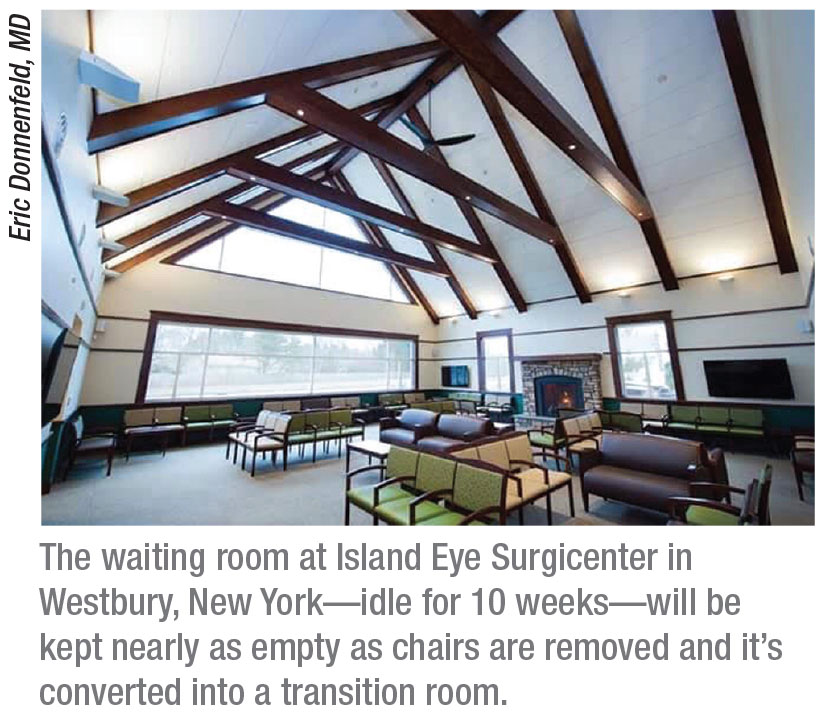 |
James Loden, MD, owner of Loden iVision Centers, which includes an ASC in Paris, Tennessee, and six offices in the state, has spent a lot of time at his desk while cut off from elective procedures, working on plans to stay in business during a 50-day shutdown. He reopened May 4, maximally meeting the safety needs of his patients and staff while developing strategies to recover lost surgical volume. For all of his calculations, however, he says he gained most of his insights on how to go from a survive to thrive mode by paying attention to his patients’ regionally-flavored wants and needs. These traits reflect the rural and metropolitan patient populations that visit his offices in three counties.
“In the metropolitan area of Nashville, we see nothing but fear, uncertainty, people wearing masks everywhere,” he says. “The challenge with them is to assure them it’s safe to visit us and undergo procedures. We’re following standard safety protocols for all patients. But in the rural areas, we have quite a bit of a different challenge. Hardly anyone in any of these areas is wearing a mask. All these patients want to know is why they couldn’t just come in and get their cataract surgery done weeks ago, and, ‘Why is the government ruining our economy?’
“We have to convince these patients and their families that we have to sacrifice some patient-centric accommodations. The families have to wait in their cars while we assess the patients under the awning outside the ASC, checking their temperatures. When checking them in, we mask everybody. Every employee is going to have an N-95 mask and eyewear. But many of the patients refuse to wear masks until we insist on it.
“We tell patients’ families to keep their cell phones turned on so we can let them know when their loved ones are ready inside the ASC. But I’d say one-quarter of the elderly family members don’t have cell phones in these rural areas. So this is another logistical problem—needing to free up staff to go out and get family members when the postop patients are ready to go home.”
Dr. Loden, fully committed to safety, has put office furnishing into storage and replaced them with sturdy plastic chairs that are cleaned every time someone sits on one. “We have labeled each room according to protocols to make sure each room is sterile,” he says. “All the knobs on the doors, the headrests, chin rests, arm rests, slit lamp, counter tops, computers and light switches have to be sanitized after every patient visit, so there are some throughput issues that can slow us down. But we need to keep the patients safe. And one thing I believe is that how we emerge from this crisis is going to depend on how well our employees perceive that we are protecting them as well. That’s just as important.”
Responding Appropriately
Dr. Loden has responded to the multiple challenges his practice faces with a mixed approach, including a web page that promotes both telemedicine and in-person visits. Virtual consultations spare patients a trip to the office when they’re planning to undergo LASIK, which Dr. Loden’s group has already begun performing, ahead of most practices.
As careful and accommodating as Loden iVision is with patients, such as gently escorting the elderly in and out of buildings, the practice also projects an undercurrent of promotion. A banner flashes upon first click on the practice’s web page, proclaiming, “All locations are now OPEN!”
“We have three surgeons who’ve had a combined 35-percent reduction in volume, which is a huge financial hit to the practice,” says Dr. Loden.
“I don’t think people are factoring that in at other practices. You have to factor in a decrease in your clinic volume and in your ASC volume—if the patients show up. Can you be viable while reducing your business 30 percent long-term? We don’t know the answer to that, and we’re modeling it right now, just like a lot of other ASCs, no doubt.” REVIEW





